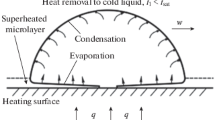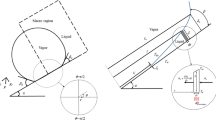Abstract
Nucleate boiling is an important part of the pool boiling phenomenon which occurs in various processes involving heat transfer, such as, steam production, chemical processes, etc. The inclination of the heated surface, where bubbles nucleates, significantly affects the bubble growth dynamics as well as the heat transfer rate from the microlayer underneath the bubble during the nucleate boiling. In this study, the effect of the surface inclination on the bubble growth and detachment during the nucleate boiling is investigated numerically. For this purpose, the proposed model of Lay and Dhir for the microlayer is modified to include the effect of the inclination of the heated surface. The resulting equations are solved numerically, and the effect of varying the inclination of the heated surface on the bubble growth and heat transfer is investigated. The results show that the largest bubble size and the highest heat transfer from the heated surface occur when the inclination of the heated surface is 30°; while, the smallest bubble size and the lowest heat transfer from the heated surface are observed for the horizontal surface. Furthermore, the total heat transfer from the inclined surface during the bubble growth increases up to 32% compared to that for the horizontal surface.













Similar content being viewed by others
Abbreviations
- A :
-
Hamaker constant J.
- а 1 :
-
Evaporation coefficient -.
- g :
-
Acceleration of gravity m/s2.
- h :
-
Latent heat kJ/ kg.
- K :
-
Interface curvature 1/m.
- k :
-
Thermal conductivity W/m.K.
- M :
-
Molecular weight g/mol.
- \( \dot{m} \) :
-
Liquid mass flow rate kg/s.
- P :
-
Microlayer pressure Pa.
- q :
-
Microlayer conduction heat flux W/m2.
- \( \dot{Q} \) :
-
Microlayer heat transfer rate W.
- R :
-
Microlayer length mm.
- r :
-
Distance from bubble base center mm.
- \( \tilde{R} \) :
-
Universal gas constant J/mol. K.
- T :
-
Temperature K.
- u :
-
Liquid velocity m/s.
- α :
-
Surface inclination -.
- β :
-
Contact angle -.
- δ :
-
Microlayer thickness mm.
- θ :
-
Tangential direction -.
- μ :
-
Viscosity kg /(m·s).
- ρ :
-
Density kg/m3.
- σ :
-
Surface tension N/m.
- c :
-
Capillary.
- con :
-
Conduction.
- d :
-
Disjoining.
- g :
-
Gravity.
- i :
-
Inner.
- int :
-
Liquid-vapor interface.
- l :
-
Liquid.
- o :
-
Outer.
- 0 :
-
horizontal surface
- r :
-
Radial direction.
- sat :
-
Saturation.
- sub :
-
Subcooled.
- sup :
-
Superheat.
- v :
-
Vapor.
- w :
-
Wall.
- z :
-
Axial direction.
References
Collier JG, Thome JR (1994) Convective boiling and condensation. Oxford University Press, New York
Jung S, Kim H (2014) An experimental method to simultaneously measure the dynamics and heat transfer associated with a single bubble during nucleate boiling on a horizontal surface. Int J Heat Mass Transf 73:365–375
Yabuki T, Nakabeppu O (2014) Heat transfer mechanisms in isolated bubble boiling of water observed with MEMS sensor. Int J Heat Mass Transf 76:286–297
FD. Moore, RB. Mesler (1961) The measurement of rapid surface temperature fluctuations during nucleate boiling of water. AICHE J 7 (4):620–624
ST. Hsu, FW. Schmidt (1961) Measured variations in local surface temperatures in pool boiling of water. ASME Journal of Heat Transfer 83 (3):254–260
Cooper M, Lloyd A (1969) The microlayer in nucleate pool boiling. Int J Heat Mass Transf 12(8):895–913
Jawurek H (1969) Simultaneous determination of microlayer geometry and bubble growth in nucleate boiling. Int J Heat Mass Transf 12(8):843–848
Voutsinos CM, Judd RL (1975) Laser interferometric investigation of the microlayer evaporation phenomenon. ASME Journal of Heat Transfer 97(1):88–92
Koffman LD, Plesset MS (1983) Experimental observations of the microlayer in vapor bubble growth on a heated solid. ASME Journal of heat transfer 105(3):625–632
Lay JH, Dhir VK (1995) Shape of a vapor stem during nucleate boiling of saturated liquids. ASME Journal of Heat Transfer 117:394–401
Oguz HN, Prosperetti A (1993) Dynamics of bubble growth and detachment from a needle. J Fluid Mech 257:111–145
Gaddis ES, Vogelpohl A (1986) Bubble formation in quiescent liquids under constant flow conditions. Chem Eng Sci 41(1):97–105
Gerlach D, Biswas G, Durst F, Kolobaric V (2005) Quasi-static bubble formation on submerged orifices. Int J Heat Mass Transf 48(2):425–438
Di Bari S, Robinson AJ (2013) Experimental study of gas injected bubble growth from submerged orifices. Exp Thermal Fluid Sci 44:124–137
Lebon M, Sebilleau J, Colin C (2018) Dynamics of growth and detachment of an isolated bubble on an inclined surface. Physical Review Fluids 3(7):073602
Siegel R, Keshock EG (1964) Effects of reduced gravity on nucleate boiling bubble dynamics in saturated water. AICHE J 10(4):509–517
Straub J (1994) The role of surface tension for two-phase heat and mass transfer in the absence of gravity. Exp Thermal Fluid Sci 9(3):253–273
Zhao JF, Li J, Yan N, Wang S-F (2009) Bubble behavior and heat transfer in quasi-steady pool boiling in microgravity. Microgravity Science and Technology 21(1):175
Dhir VK, Warrier GR, Aktinol E, Chao D, Eggers J, Sheredy W, Booth W (2012) Nucleate pool boiling experiments (NPBX) on the international Space Station. Microgravity Science and Technology 24(5):307–325
Warrier GR, Dhir VK, Chao DF (2015) Nucleate pool boiling experiment (NPBX) in microgravity: international Space Station. Int J Heat Mass Transf 83:781–798
MG. Kang (2000) Effect of tube inclination on pool boiling heat transfer. J Heat Transf 122 (1):188–192
Sarangi S, Weibel JA, Garimella SV (2015) Effect of particle size on surface-coating enhancement of pool boiling heat transfer. Int J Heat Mass Transf 81:103–113
Mehta JS, Kandlikar SG (2013) Pool boiling heat transfer enhancement over cylindrical tubes with water at atmospheric pressure, part I: experimental results for circumferential rectangular open microchannels. Int J Heat Mass Transf 64:1205–1215
Kim NH, Choi K-K (2001) Nucleate pool boiling on structured enhanced tubes having pores with connecting gaps. Int J Heat Mass Transf 44(1):17–28
Kutateladze SS (1990) Heat transfer and hydrodynamic resistance. Energoatomizdat Publishing House, Moscow Handbook, Chapter 12(7):151
Phan HT, Caney N, Marty P, Colasson S, Gavillet J (2009) How does surface wettability influence nucleate boiling? Comptes Rendus Mécanique 337(5):251–259
Rousselet YL (2014) Interacting effects of inertia and gravity on bubble dynamics. University of California, Los Angeles
Singh S, Dhir V (2000) Effect of gravity, wall superheat and liquid subcooling on bubble dynamics during nucleate boiling. Microgravity Fluid Physics and Heat Transfer:106–113
Cooke D, Kandlikar SG (2012) Effect of open microchannel geometry on pool boiling enhancement. Int J Heat Mass Transf 55(4):1004–1013
Sato Y, Niceno B (2015) A depletable micro-layer model for nucleate pool boiling. J Comput Phys 300:20–52
Son G, Dhir VK, Ramanujapu N (1999) Dynamics and heat transfer associated with a single bubble during nucleate boiling on a horizontal surface. ASME Journal of Heat Transfer 121:623–631
Abdoli Tondro A, Maddahian R, Arefmanesh A (2019) Assessment of the inclination surface on the microlayer behavior during nucleate boiling, a numerical study. Heat Mass Transf 21. https://doi.org/10.1007/s00231-091-02566-5
Mei Y, Zhu Y, Zhang B, Gong S, Gu H Effects of Heater Material and Surface Orientation on Heat Transfer Coefficient and Critical Heat Flux of Nucleate Boiling. In: 2017 25th International Conference on Nuclear Engineering, 2017. American Society of Mechanical Engineers, pp V006T008A083–V006T008A083
Mei Y, Shao Y, Gong S, Zhu Y, Gu H (2018) Effects of surface orientation and heater material on heat transfer coefficient and critical heat flux of nucleate boiling. Int J Heat Mass Transf 121:632–640
Dadjoo M, Etesami N, Esfahany MN (2017) Influence of orientation and roughness of heater surface on critical heat flux and pool boiling heat transfer coefficient of nanofluid. Appl Therm Eng 124:353–361
Kim T, Kim JM, Kim JH, Park SC, Ahn HS (2017) Orientation effects on bubble dynamics and nucleate pool boiling heat transfer of graphene-modified surface. Int J Heat Mass Transf 108:1393–1405
Jung S, Kim H (2016) Effects of surface orientation on nucleate boiling heat transfer in a pool of water under atmospheric pressure. Nucl Eng Des 305:347–358
Sadaghiani AK, Motezakker AR, Özpınar AV, İnce GÖ, Koşar A (2017) Pool boiling heat transfer characteristics of inclined pHEMA-coated surfaces. J Heat Transf 139(11):111501
Kibar A, Ozbay R, Sarshar MA, Kang YT, Choi C-H (2017) Bubble movement on inclined hydrophobic surfaces. Langmuir 33(43):12016–12027
Tanjung EF, Jo D (2019) Surface orientation effects on bubble behaviors and critical heat flux mechanism in saturated water pool. Int J Heat Mass Transf 133:179–191
Kang MG (2010) Pool boiling heat transfer on the tube surface in an inclined annulus. Int J Heat Mass Transf 53(15):3326–3334
Kaneyasu N, Yasunobu F, Satoru U (1984) Effect of surface configuration on nucleate boiling heat transfer. Int J Heat Mass Transf 27(9):1559–1571
Sateesh G, Das SK, Balakrishnan AR (2009) Experimental studies on the effect of tube inclination on nucleate pool boiling. Heat Mass Transf 45(12):1493–1502
Howard AH, Mudawar I (1999) Orientation effects on pool boiling critical heat flux (CHF) and modeling of CHF for near-vertical surfaces. Int J Heat Mass Transf 42(9):1665–1688
Wu J, Dhir VK (2010) Numerical simulations of the dynamics and heat transfer associated with a single bubble in subcooled pool boiling. J Heat Transf 132(11):111501
Wayner PC (1992) Evaporation and stress in the contact line region. In: Proceedings of the Engineering Foundation Conference on Pool and External Flow Boiling, pp 251–256
Hickman KCD (1954) Maximum evaporation coefficient of water. Industrial & Engineering Chemistry 46(7):1442–1446
Aktinol E (2014) Numerical simulations of bubble dynamics and heat transfer in Pool boiling--including the effects of conjugate conduction, level of gravity, and noncondensable gas dissolved in the liquid. Mechanical Engineering, University of California Los Angeles, Ph.D.
Author information
Authors and Affiliations
Corresponding author
Ethics declarations
Conflict of interest
The authors declare that they have no conflict of interest.
Additional information
Publisher’s note
Springer Nature remains neutral with regard to jurisdictional claims in published maps and institutional affiliations.
Rights and permissions
About this article
Cite this article
Tondro, A.A.A., Maddahian, R. & Arefmanesh, A. Effect of heated surface inclination on the growth dynamics and detachment of a vapor bubble, a numerical study. Heat Mass Transfer 57, 205–222 (2021). https://doi.org/10.1007/s00231-020-02937-3
Received:
Accepted:
Published:
Issue Date:
DOI: https://doi.org/10.1007/s00231-020-02937-3




